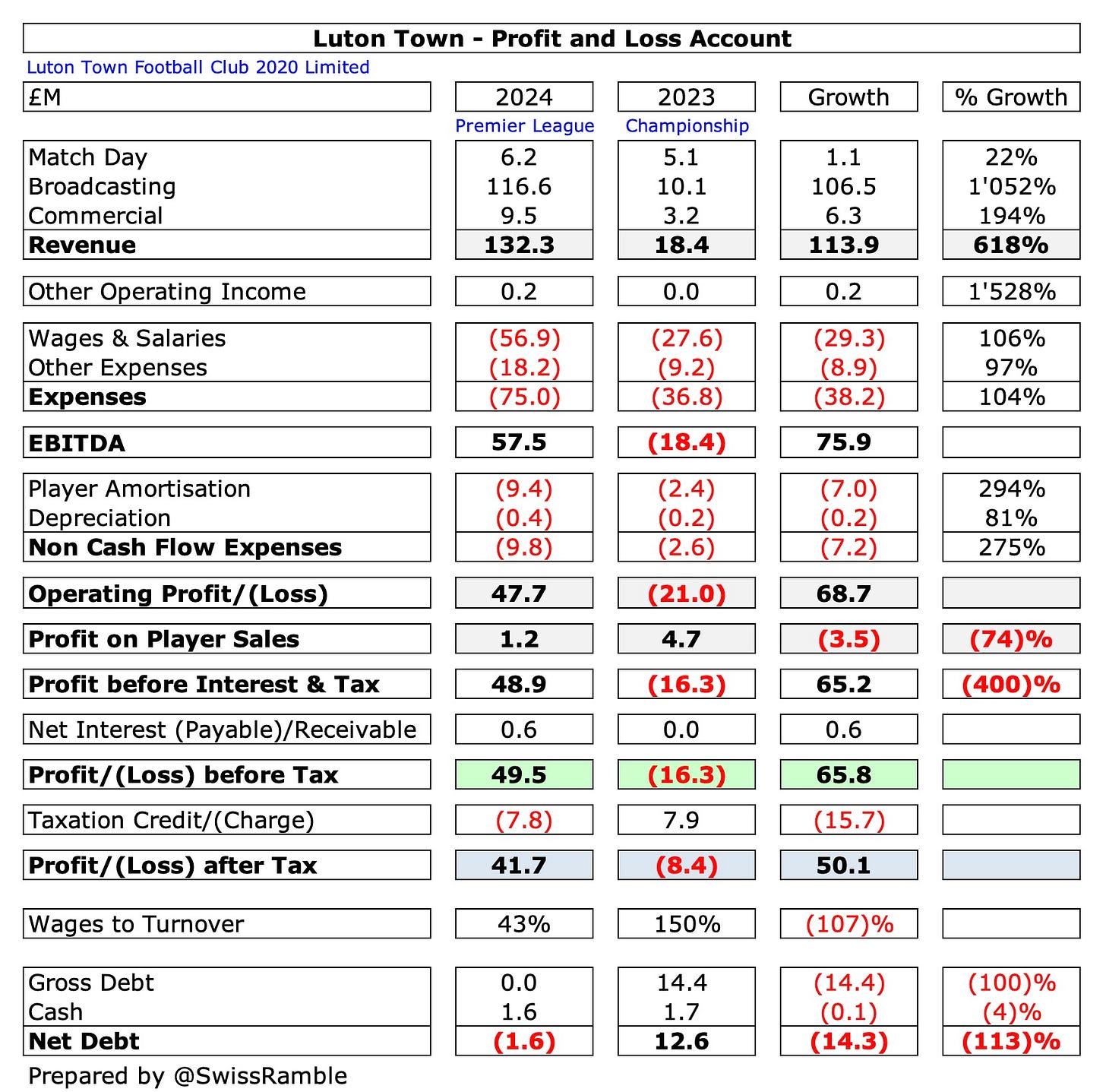Luton Town’s relegation from the Championship to League One was confirmed on the last day of the season, when they were beaten 5-3 by West Bromwich Albion.
After the joy of being the first team to go from the National League to the Premier League, they became only the fourth team to suffer successive relegations from the top flight, following Sunderland (2017/18), Wolverhampton Wanderers (2012/13) and Swindon Town (1994/95).
Stability
Although things have taken a turn for the worse on the pitch, the club’s finances look in pretty good shape.
This was referenced by chief executive Gary Sweet after the double relegation, “The backdrop of our custodianship of the football club is financial stability. It’s an absolute cornerstone. The club was unstable, it’s more stable now than it probably ever has been financially and structurally.”
What goes up must come down
This approach is understandable if you know the club’s history, as Sweet explained, “Whilst the new generation of Luton fans won’t have the memory of what happened prior to our ownership, we went through three administrations in a fairly short period at a time.”
The chief executive added, “Last year was our first relegation since 2008/09 and for a club that is renowned for a rollercoaster ride, that’s some going. We’ve had four promotions since then. We know how to handle the transition going upwards, but that first summer last year was the first time we’ve had to manage it going the other way. We have learnt an awful lot from that.”
History
Looking further back, Luton were relegated on the last day of the 1991/92 season, thus depriving them of a place in the shiny new Premier League. Since then, the club has been on a long journey, which took them all the way down to the Conference, including a spell in administration in 2007/08.
These financial issues led to the FA imposing a massive 30-point fine, which effectively sealed the club’s fate. Many supporters still haven’t forgiven the football authorities for kicking them when they were down.
However, Luton proceeded to demonstrate great “bouncebackability”, steadily moving the club up the football pyramid, leading to a shock promotion to the Premier League for the first time in the club’s history, when they defeated Coventry City in the 2022/23 Championship play-off final after a nail biting penalty shoot-out.
Limited Investment
The club’s sustainable approach resulted in limited expenditure on the squad after promotion to the top flight. Instead, the club invested much of their windfall gains in building a new stadium.
While such investment will be beneficial to Luton’s long-term prospects, it is clear that this strategy had an adverse impact on their ability to compete in the Premier League.
Indeed, the directors admitted that they had probably under-spent in the transfer market, especially in the January window, as they attempted to stay up: “In hindsight the club might have reinforced more.”
Although Luton acquitted themselves reasonably well, notching up wins against Newcastle United and Brighton, as well as drawing with champions Liverpool, the reality was that their resources were much less than their rivals.
It was therefore not a major surprise that they struggled, as the club was effectively fighting with one hand behind it’s back.
They had over-performed their budget in the Championship, but the odds were against them repeating this feat in the Premier League.
Financials
A look at the latest available accounts from 2023/24, comparing Luton to the other clubs in the Premier League, very clearly highlights the magnitude of their challenge.
In fact, that season “ultimately ended in disappointment”, as the club finished in 18th place, which led to relegation back to the Championship, while the downward slide continued last season.
Profit/(Loss) 2023/24
As a result of promotion to the Premier League, Luton set new records for both revenue and profits in 2023/24.
They swung from a £16.3m pre-tax loss in the Championship to £49.5m profit, a huge improvement of £65.8m in the bottom line. Revenue shot up from £18.4m to £132.3m, though this was partially offset by a significant increase in operating expenses, which more than doubled from £39.4m to £84.9m.
Profit from player sales (including compensation) fell £3.5m from £4.7m to just £1.2m.
After tax, Luton went from an £8.4m loss to £41.7m profit. The year-on-year £50.1m improvement was smaller than before tax, as the club had a £7.8m tax charge, as opposed to a £7.9m tax credit the previous season.
The main driver of Luton’s revenue growth was broadcasting, which rose a staggering £106.5m from £10.1m to £116.6m, due to the far more lucrative Premier League TV deal (more than ten times as much as the Championship).
There was also good growth in the other revenue streams, especially commercial, which virtually tripled from £3.2m to £9.5m. Match day increased by 22%, rising £1.1m from £5.1m to £6.2m.
However, Luton had to invest in the squad to give them any chance of competing in the top flight.
As a result, wages more than doubled from £27.6m to £56.9m, while the increase in player amortisation was even more pronounced, as this almost quadrupled from £2.4m to £9.4m. In addition, other expenses doubled from £9.2m to £18.2m.
Luton’s £49m pre-tax profit was the fifth best result in the Premier League last season, as a few other clubs managed to generate even more impressive profits, namely Brighton £75m, Manchester City £74m and West Ham £57m.
Keep reading with a 7-day free trial
Subscribe to The Swiss Ramble to keep reading this post and get 7 days of free access to the full post archives.







